Matador Network's Blog, page 1030
August 21, 2019
Best artificial reefs
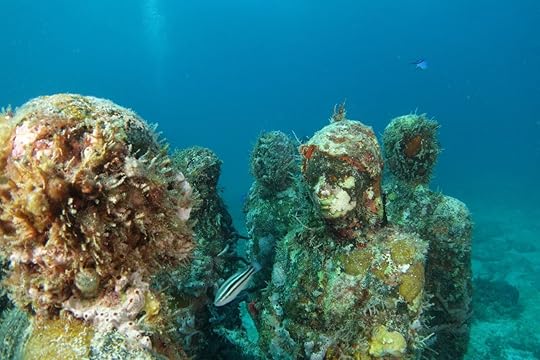
Coral reefs are playgrounds for scuba divers, but like any city park with dilapidated swings and rusty slides, they’re susceptible to wear and tear from those who come to enjoy them. Add in environmental pressures like coral bleaching, rising ocean temperatures, and acute weather, and it’s clear to see why the world’s reefs are at high risk of irreparable damage.
Artificial reefs are one solution to degrading ecosystems that have become both increasingly common and controversial over the past few decades. The idea is simple: Sinking man-made structures such as ships gives small sea creatures like barnacles something to attach to, thereby drawing larger marine life and, ultimately, establishing new habitats.
According to the US Department of the Interior’s website, “Artificial reefs provide shelter, food, and other necessary elements for biodiversity and a productive ocean. This in turn creates a rich diversity of marine life, attracting divers and anglers.” As dive sites, these artificial reefs have the potential to divert tourist attention away from struggling natural reefs.
The practice is still under some scrutiny, however. Critics of man-made reefs cite the issues of pollution, durability, and the fact that shuffling around underwater traffic rather than curbing it remains problematic for wildlife, whether species have made their homes by atolls or wrecks. While the jury is still deliberating on the long-term effectiveness of artificial reefs, destinations ranging from Mexico to Thailand have embraced them, seeing promising growth in their marine populations and creating new underwater attractions for divers.
These are seven of the coolest diving experiences you can have in artificial reefs.
1. Tour an underwater military museum in the Gulf of Aqaba.

Photo: Shahar Shabtai/Shutterstock
Earlier this year, Jordan sank 19 military vehicles in the Red Sea off the coast of Aqaba, the nation’s lone port city. The retired conveyances range from troop carriers to tanks, even a helicopter, which have been arranged in a tactical formation between 65 and 95 feet down. Part artificial reef, part underwater museum, the display is intended to both promote tourism and benefit marine life.
According to the , which previously worked with the United Nations Development Programme to relocate threatened coral reefs, all vehicles were stripped of potentially damaging materials before being sunk. If everything goes to plan, the site will redirect divers away from threatened Red Sea reefs, and the museum will add even more vehicles once they become available.
2. Discover the Lost City of Atlantis at Florida’s Neptune Memorial Reef.
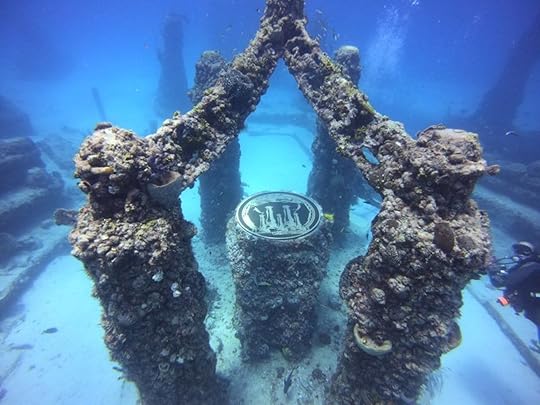
Photo: Neptune Memorial Reef/Facebook
A few miles east of Miami’s Key Biscayne sits an artificial reef that bills itself as the largest man-made reef ever created. Though it eventually plans to cover more than 16 acres, the site currently has two main draws. The first is an interpretation of the Lost City of Atlantis located 40 feet deep, a comfortable depth for even novice divers. Also a member of the Green Burial Council, the Neptune Memorial Reef is a memorial site where friends and family can lay their loved ones to rest, having their cremated remains built right into the sunken city.
Studies have shown that marine life is taking to the artificial reef swimmingly, pun intended, which abides by strict environmental regulations imposed by the EPA, DERM, NOAA, Florida Fish and Wildlife, and Army Corps of Engineers. The reef is free for all divers.
3. Glide through a sculpture garden off Mexico’s Caribbean Coast.

Photo: Krofoto/Shutterstock
Like many, Mexico’s reefs are suffering from overtourism. In an effort to alleviate them, British artist and former scuba instructor Jason de Caires Taylor created an underwater installation in the National Marine Park spanning Cancún, Isla Mujeres, and Punta Nizuc. The site showcases hundreds of underwater statues, mostly of human bodies arranged in various positions and incorporating various props. The sculptures were made using extra durable cement with a neutral PH to not disturb sea life, and damaged coral was replanted on the sculptures, making them even more eco-friendly and eye-catching.
4. See decommissioned subway cars in the Mid-Atlantic.
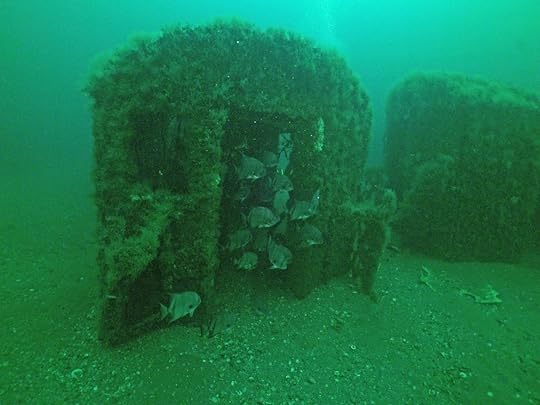
Photo: New York Transit Museum/Facebook
Poll commuters at rush hour, and most will say that the NYC subway is a necessary evil, a boon that’s appreciated but not exactly enjoyed. Sneak a peek at subway cars submerged 80 feet underwater, however, and you’ll be blown away by the MTA’s transit system. Prepare for chilly waters and make your first stop Redbird Reef off Slaughter Beach in Delaware to see more than 700 retired Redbird cars teeming with species like black sea bass and flounder. Also included in the reef are numerous tanks, barges, and tires.
In total, over 2,000 decommissioned Redbirds and Brightliners have been sunk in the Atlantic off the coasts of New Jersey, South Carolina, Virginia, Maryland, and Georgia. Though the cars are stripped and cleaned before being dumped, the project was met with raised eyebrows in the early stages from environmental groups claiming the decontamination process left something to be desired. Nonetheless, the impact on marine life ranging from fish and lobsters to corals and sponges has been demonstrable, making the reefs popular not only with sea creatures but also divers and anglers. Non-divers can also appreciate the sunken subway cars thanks to a photo series by Stephen Mallon that chronicles their submersions over three years.
5. Support the Rigs to Reef program in the Gulf of Mexico.

Photo: Richard Whitcombe/Shutterstock
Offshore drilling is a blight on the environment, but removing oil rigs can be even more damaging to underwater ecosystems than simply decommissioning them. Transforming these rigs into artificial reefs by removing their tops and letting their bodies be, however, has proven beneficial to marine life. The metal structures make surprisingly good homes for corals, fish species, and other sea creatures, a fact the Rigs to Reef program has been capitalizing on for decades.
More than 532 divable platforms have been created off the Gulf Coast of the United States ever since the National Artificial Reef Plan was passed in 1985. Alabama, Texas, Louisiana, Florida, and Mississippi all participate in the program in accordance with strict, state-specific reef laws, though California has converted several of its own rigs into artificial reefs. Similar projects have also been successful in Malaysia, Brunei, and elsewhere.
6. Head to Thailand to dive among reef cubes.

Photo: think4photop/Shutterstock
With its warm waters, sharks and rays, and countless scuba schools, Koh Tao has earned its reputation as one of Thailand’s leading dive islands. Since 2015, there’s been yet another reason to visit: the Koh Tao reef cubes. Hundreds of concrete cubes have been scattered around the island by the New Heaven Reef Conservation Project, following an initiative started by the Department of Marine and Coastal Resources. Despite being hollow frames, each weighs upward of a ton, and they’ve been arranged in a geometric pattern to create an underwater display that doubles as modern art. Reef cubes have also been sunk off the coast of Phuket.
7. Swim by a Boeing 747 at Bahrain’s massive underwater theme park.

Photo: Dive Bahrain/Bahrain Tourism & Exhibitions Authority
Air travel can be draining, but boarding a 747 that’s submerged 80 feet under the sea is anything but a drag. Thanks to Dive Bahrain, which the island nation claims will be the largest underwater theme park in the world at over a million square feet, you’ll be able to do just that. Though the park is slated to open later this summer, the 200-plus-foot Boeing aircraft has already been sunk, nose up so it’s accessible to divers of all experience levels.
According to Dive Bahrain, the 747 was stripped of all wires, hydraulics, plastic and rubber parts, and other hazardous materials, as well as being washed with ocean-safe detergents to ensure it was fit to be sunk without harming sea life. Alongside the submerged plane, the massive marine park will also feature artificial coral reefs, eco-friendly sculptures, and a replica pearl merchant’s house, a fitting addition as Bahrain’s economy was largely built on pearl diving. Not only will this bring Six Flags levels of fun to the ocean floor, but the marine park also hopes that the project will help researchers learn more about the local ecology. 

More like this: Scuba diving in Baja California is one of Mexico’s best-kept secrets
The post 7 artificial reefs every scuba diver needs to see appeared first on Matador Network.

August 20, 2019
French Riviera on a budget

There’s plenty of fun to be had yacht cruising, casino crawling, and celebrity spotting, but the luxury and flashiness of Monte Carlo and Cannes represents a tiny, clichéd fraction of the South of France. Beyond the red carpet of the film festival, Nice’s Promenade des Anglais, and the Grimaldis’ Palace, there is a region filled with simple pleasures, amazing landscapes, and a chill atmosphere. To discover the true-to-life Riviera away from the stereotypes of wealth and designer fashion, follow this travel itinerary.
Check out Marseille instead of Nice.

Photo: S-F/Shutterstock
The westernmost point of your journey should be Marseille — and chances are that flight prices will be significantly lower for this airport than for Nice’s. In the past, the second largest city in France had a gritty reputation filled with scare stories of high crime. In reality, however, travelers are in no more danger there than in Paris.
The port city is the perfect spot to explore a culinary scene you did not know about. With a large community from Algeria, Tunisia, and Morocco, there are plenty of opportunities to enjoy traditional North African cuisine. Try Le Fémina, an Algerian restaurant that makes a traditional couscous that you’re not likely to forget any time soon.
If it’s views of the Mediterranean that you’re after, take the easy climb up to the hilltop basilica Notre Dame de la Garde. The Mistral — the exhilarating wind typical of this region — is likely to blow your hair at all angles and leave you breathless, but it’s well worth having bad hair for the rest of the day.
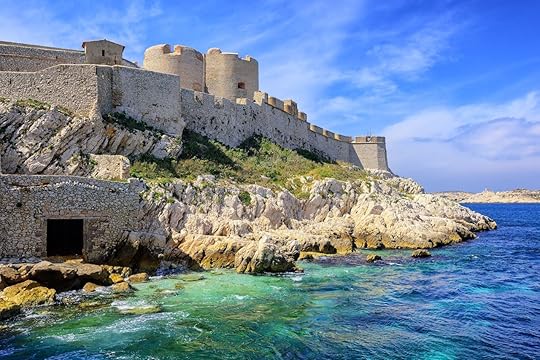
Photo: Boris Stroujko/Shutterstock
Finally, take a boat trip from the Vieux Port to the tiny island of If where you can visit the Chateau D’If, a majestic fortress that was once host to prisoners and was featured in the legendary Alexandre Dumas novel The Count of Monte Cristo.
Spend the night in a bubble.
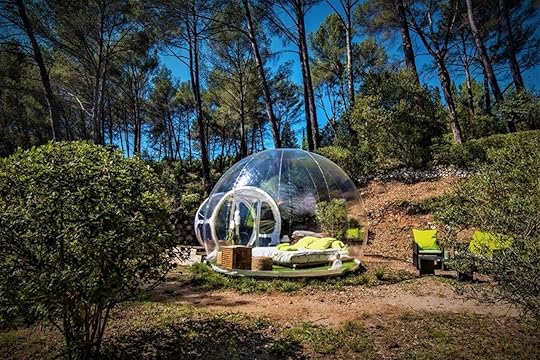
Photo: Attrap’Rêves/Facebook
A day spent in the bustling city of Marseille can be perfectly balanced out by retreating to the solitude and sanctuary of the forest by night. About six miles from Marseille’s St. Charles train station lies a Provencal pine forest within which is perhaps the most unusual hotel complex you’ll encounter in all of France: Attrap’Rêves. Here, amid the trees, are several transparent bubbles, each with its own unique décor and theme, and you can spend the night inside one. In the daytime, carefree squirrels scuttle in the woodland around you, and after dark, the entertainment is focused on the sky, courtesy of the telescopes provided in each bubble.
Visit the Marquis de Sade’s former home.

Photo: Hôtel Château de Mazan/Facebook
A brief detour inland, a little more than an hour from Marseille, will take you to the former home of France’s most famous villain — the Marquis de Sade. Known as the Chateau Mazan, the beautiful residence became a hotel in 2001.
Aside from a handful of tasteful artistic nudes on the walls, nothing about this quiet residence in a sleepy Provencal village even begins to suggest the depravity with which de Sade’s name is associated.
A night’s stay is highly recommended to fully take in the landscaped garden and the outdoor pool, but you can also enjoy a short stay by indulging in a meal of duck foie gras terrine and roasted apricot in the historic dining room.

Photo: jakubtravelphoto/Shutterstock
Nearby, in the beautiful perched mountain village of Lacoste, the chateau where de Sade staged some of his most epic plays back in the 18th century lies abandoned in ruins. The site has been rescued by fashion designer Pierre Cardin, although he has so far resisted the temptation to renovate, so the remains are free to wander around in at any time. Note, however, that the spot comes to life during its annual summer festival. Each year opera, dance, and drama performances take place in the chateau’s dramatic grounds and around its ancient quarry. Next July will mark the 20-year anniversary of the festival, so an extra-special program is promised.
Do Cannes differently.

Photo: Nigel savory/Shutterstock
Skip sightseeing in St. Tropez, an overrated fishing village glamorized purely by its connection to movie starlets like Brigitte Bardot. That said, you could do worse than a visit to a place like Hotel Pastis. Named after the traditional anise liqueur for which this region is renowned, it prides itself on being a family-run hotel, offering a fully stocked bar. A drink here is a great way to quench your thirst before getting back on the road.
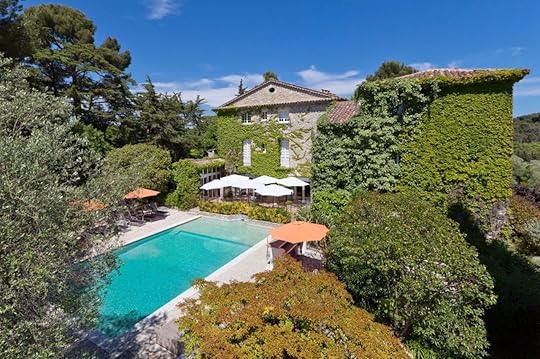
Photo: Manoir de l’Etang/Facebook
Later, continue to Cannes, but consider heading uphill to make your base the village of Mougins, Picasso’s former home. Only five miles from the celebrity mansions and Rolex-clad high-rollers is a completely different vibe — one of quiet contemplation, breathtaking scenery, and art galleries. Make sure you check out the Mougins Museum of Classical Arts and the Museum of Photography, where you’ll see many portraits of Picasso by famous photographer Villiers. Hotel-wise, the Manoir De L’Etang — once home to architect Maurice Gridaine who built the now-legendary Palais de Festival on Cannes’s Croisette — is simple, yet elegant. The surrounding environment and the killer views are sure to make any visitors weak at the knees.
Leave the mainland for a peaceful stroll among vineyards.
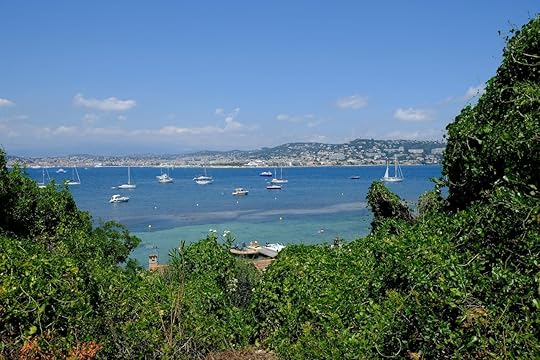
Photo: roberto muratore/Shutterstock
Do not leave the Cannes area without visiting the isolated Îles des Lérins, 15 minutes by boat from the city. Known as the “twin emerald isles,” they are free of all traffic and occupied only by wine-producing Cistercian monks. Hidden coves, deserted beaches, and acres of vineyards all await at Île Sainte-Marguerite, far from the crowds. This location is also home to Fort Royal, the 17th-century building where the legendary Man In The Iron Mask was imprisoned.
Across the bay lies the island’s slightly smaller sister, Île Saint-Honorat. The award-winning wine produced by the monks here has been known as the drink of choice for the jury of the famous film festival. Look out for Saint Salonius — this pinot noir treasure at the gift shop is the island’s only concession to consumerism. Cars and bikes are totally forbidden, so the only option is to traverse these tiny islands on foot.
Check out France’s most beautiful village and the road to Nice.

Photo: Kiev.Victor/Shutterstock
The Riviera is known for the beauty of its perched villages, and one of the most stunning is Èze, although — with the exception of a picturesque seaside walking trail known as the Nietzsche path — it’s difficult to escape the crowds here. But fear not: There are other contenders.
Possibly the most picturesque village on the Riviera — yet also the most under-celebrated — is Cagnes-sur-Mer. Characterised by steep, narrow alleyways with crumbling walls, a walk through this village quickly rewards visitors with gorgeous panoramas. It’s at its best during spring and summer, when blooms in shades of deep purple and fuchsia pink cover the place, but the village is beautiful all year round.
The obvious choice for accommodation here is Chateau Le Cagnard — a 13th century medieval castle turned hotel, which is a contender for the best place to stay in all of France. The icing on the cake is its restaurant’s frescoed ceiling and 200-centuries-old illustrated panels, which slide back after dark to reveal a twinkling night sky.
Cagnes-Sur-Mer is about a 15- to 20-minute drive from the Nice airport. Yet if you choose to linger before a flight, head to Menton, the last town before the Italian border. Every March, it is host to the Fête du Citron, a festival of sculptures built entirely out of the lemons for which the area is renowned. 

More like this: The ultimate guide to vacationing in Monte Carlo like James Bond
The post How to travel to the real French Riviera, away from the glitz and glamour appeared first on Matador Network.

Bikini Atoll beer prompts backlash
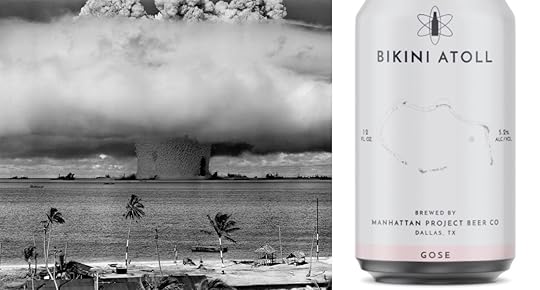
Texas-based Manhattan Project Beer Company is facing backlash following the release of a new beer named after Bikini Atoll, the site of numerous nuclear tests in the wake of World War II. Pacific Islanders who found the name offensive or insensitive called out the company on Twitter, and the Marshall Islands government weighed in disapprovingly.
In 1946, the 167 residents of Bikini Atoll, located in the Marshall Islands, were forced to relocate to nearby Rongerik so that the United States could test bombs during the Cold War. Between 1946 and 1958, the United States detonated 23 atomic and hydrogen bombs on the islands — many of which were more powerful than those dropped on Japan at the end of the war. The atoll became uninhabitable.
The residents of Bikini Atoll were exiled from their home until 1969 when the United States government finally allowed them to resettle (they had already moved several times because many atolls, like Rongerik, didn’t have the resources to support their community). Yet radiation levels were still so high on Bikini Atoll that the remaining residents had to be evacuated again in 1978. The ancestors of the original Bikini Atoll evacuees are still without a permanent home, reduced to a nomadic community. Bikini Atoll itself is still too contaminated by radiation to be safe for human life.
Given that many generations of Marshall Islanders have been subjected to ongoing health issues, including cancer and birth defects, it is perhaps unsurprising that Manhattan Beer Project’s use of the Bikini Atoll name to sell beer was not warmly received. Twitter users called the beer’s name “entirely inappropriate,” “tone-deaf and offensive,” and accused the company of “practicing willful disregard for Indigenous lives.” A petition even surfaced demanding that stores like Whole Foods stop the sale of the Bikini Atoll beer.
The Manhattan Project Beer responded to the backlash with a statement posted on its social media channels insisting that it did not intend to “mock or trivialize” nuclear testing or the suffering of the people of Bikini Atoll. The company even tried to claim that the beer would “raise awareness” (no donations from the proceeds of the beer are currently being offered to the people of Bikini Atoll) and added that Manhattan Project Beer employees have received harassment and death threats.
Eventually, the government of the Marshall Islands waded into the controversy with a stern warning of its own: Jack Niedenthal, the Marshall Islands’ secretary of health and human services, released a statement which reads in part: “On… behalf of the people of the Marshall Islands, I highly encourage you to discard this ill-conceived product forever, and moreover, I believe you need to issue a public apology to our people.”
The Bikini Atoll gose is part of an arguably very misguided collection of beers named for weapons of mass destruction (yes, you read that right). The other beers in the line include the Hoppenheimer (so named for the inventor of the atomic bomb), Necessary Evil, Half-Life, and Plutonium-239. 

More like this: Maine replaces Columbus Day with Indigenous Peoples’ Day
The post Brewery faces backlash, boycotts from Marshall Islands after Bikini Atoll beer appeared first on Matador Network.

‘Plastic Ocean’ underwater art piece
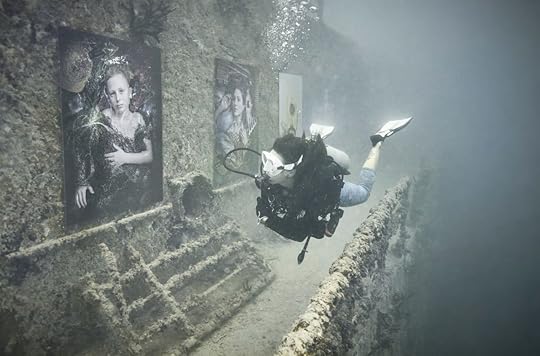
Usually, plastic in the ocean is a bad thing. In this case, people dove down not to collect it but to marvel at it. The 24-piece “Plastic Ocean Project” was an underwater art exhibit by photographer Andreas Franke of Austria, attached to the Gen. Hoyt S. Vandenberg shipwreck. After spending three months submerged — collecting the ocean’s salt, algae, and microorganisms — it has just been retrieved by divers.
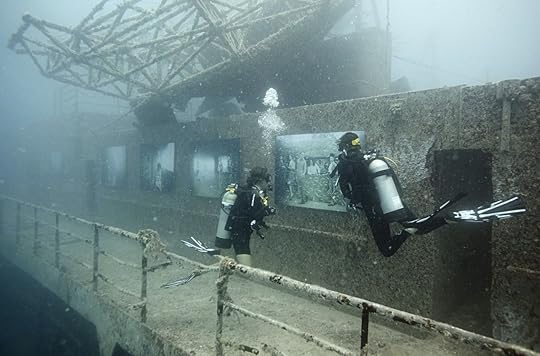
Photo: Plastic Ocean
The plastic images are meant to represent the beauty of this world and its future generations. In addition to human images, they include written messages that raise awareness of the issue of plastic pollution. Accruing microorganisms was part of the exhibit’s thematic purpose as each piece was transformed in a unique way by elements of the sea. Franke hoped that this would highlight the ocean’s beauty and the urgent need to protect it.
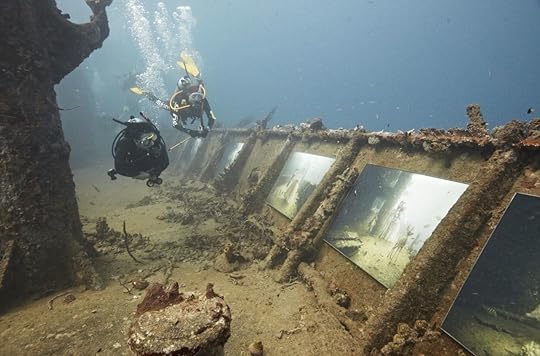
Photo: Plastic Ocean
Now, you won’t have to be a diver to view the plastic exhibit. Once the artwork dries, Franke will display the plastic pieces at a Florida art gallery that has not yet been announced.
For a dose of Franke’s works, however, some of his originals and prints from his previous “The Sinking World” series will be on display at 7 Artists Gallery on August 21, with a happy hour and meet-the-artist reception. 

More like this: Everything that happens when you give up single-use plastic
The post Underwater art exhibit made of plastic surfaces in the Florida Keys appeared first on Matador Network.

Animals saved from extinction

It is a hard pill to swallow that Earth is in the midst of a mass extinction event, driven almost entirely by human activities. In order to halt the decline in global biodiversity, in 2010 the governments of 193 countries that are part of the UN Convention on Biological Diversity committed to protecting 17 percent of land and 10 percent of oceans across the globe by 2020.
Reaching these targets requires a significant financial investment. A study published in Science in 2010 estimated the required global conservation at $76.1 billion annually. With such expenditure, it is reasonable to question whether wildlife conservation actually works.
To answer this question, a group of researchers from Oxford University, together with their colleagues in the US and Canada, investigated the effectiveness of conservation spending on biodiversity between 1996 and 2008 in 109 countries — the signatories to the UN Convention on Biological Diversity. They found that conservation investment reduced biodiversity loss by an average of 29 percent per country. Furthermore, the study published in Nature demonstrated that with additional funding, a 50 percent decline in biodiversity loss can be achieved.
Looking back at the last few decades, here are some of the greatest conservation success stories of saving species in extremis.
1. Humpback whale

Photo: Trevor Scouten/Shutterstock
Famous for their epic migrations and spectacular breaches, humpback whales are some of the most popular large mammals in the world. Unfortunately, in the 19th and 20th centuries, they were popular for all the wrong reasons, namely their meat and blubber (the layer of fat that allows humpbacks to withstand the sub-zero temperatures of the Southern Ocean).
Hundreds of thousands of humpbacks were killed during the 20th century, reducing the global population by more than 90 percent. By the 1970s, when commercial whaling was finally banned, the Australian east coast migratory population numbered no more than 300 whales, and the North Atlantic population shrank to as few as 700 individuals.
The hunting ban was the key turning point for the whales. Over the next four decades, the humpbacks made an epic comeback from the brink of extinction. Today, more than 30,000 humpback whales migrate along the east coast of Australia each year, and the global population is thought to number over 80,000 individuals.
2. Siberian tiger

Photo: Stanislav Duben/Shutterstock
The largest wild cat on Earth, the Siberian tiger is also the most endangered. Once, Siberian tigers roamed throughout the Russian Far East, parts of China, and the Korean peninsula. But systematic hunting and capturing of tigers for zoos reduced the wild population to as few as 40 individuals by the 1940s. The world came perilously close to losing one of its most magnificent wild cats.
Thankfully, in 1947 Russia afforded full legal protection to the Siberian tiger, and the population slowly began to recover. In 1992, the Siberian Tiger Project — a joint initiative between the Wildlife Conservation Society and Sikhote-Alin Reserve in Russia — was established to study the ecology and conservation biology of the Siberian tiger in the Russian Far East. To date, more than 60 tigers have been outfitted with radio collars, allowing the researchers to gather data on tigers’ social structure, habitat requirements, reproduction, and survival rates.
The data collected by the project team has been used to improve protection of tigers and their prey species. As a result, the population of the Siberian tiger in Russia increased to 502 individuals, according to the 2015 census. And while the Siberian tigers is not quite out of the weeds, its population is considered stable and slowly increasing.
3. Giant panda

Photo: PHOTO BY LOLA/Shutterstock
Perhaps the most recognizable symbol of the global wildlife conservation efforts is the giant panda. After decades of being poached for its hide, this adorable bamboo forest specialist native to the high mountains of western China was on the brink of extinction by the 1960s, with only a handful of individuals surviving in the wild.
The Chinese government’s crackdown on poaching in the 1980s came in the nick of time to save the giant panda from teetering over the edge. The following decades saw the establishment of a network of 67 giant panda reserves interconnected by wildlife corridors that allowed individual animals to travel between populations to maintain the necessary gene flow.
To evaluate the success of giant panda conservation measures, the Chinese government carries out extensive national surveys once every decade. The most recent survey, conducted from 2011 to 2014, included more than 2,000 people surveying 43,600 square kilometres of panda habitat. The results of the survey revealed the growing trend in the giant panda population with an estimated 1,864 pandas living within the surveyed area — an increase of 17 percent from the previous survey in 2003.
While some experts question the extent of the population growth reported by the survey, the International Union for Conservation of Nature downgraded the status of the giant panda from endangered to vulnerable in 2016.
4. Golden lion tamarin

Photo: Edwin Butter/Shutterstock
Despite such a grand name, golden lion tamarins are tiny primates that weigh all of 260 grams. They have impressive manes, reminiscent of Africa’s big cat; bright reddish-orange coats; and hairless faces. Many consider them the most beautiful tamarin species.
Golden lion tamarins live in the Atlantic coastal forest in Brazil where they forage for fruit and insects in small social groups. Unfortunately for the tamarins, people also like to live in the coastal areas in Brazil. Over the years, most of the Atlantic forest has been cleared and replaced with cities like Rio de Janeiro. Only about five percent of the golden lion tamarins’ habitat remains today.
Consequently, by the early 1990s, the species was teetering on the brink of extinction, with possibly as few as 200 individuals scattered among isolated populations. What came next was the world’s first attempt to reintroduced captive-bred animals into the wild to bolster the dwindling numbers.
The reintroduction was fraught with difficulties. The early attempts failed because the zoo animals did not know how to survive in the wild. Desperate to save the species, the experts designed elaborate training environments to teach captive tamarins how to avoid predators and find food. Eventually, it worked, and the population started to stabilize. Today, there are about 1,000 golden lion tamarins living in the protected reserves and on nearby ranches in the state of Rio de Janeiro.
5. Southern white rhino

Photo: EcoPrint/Shutterstock
Rhinos are one of the most heavily poached wildlife species in the world. Once, they roamed throughout Eurasia and Africa and numbered over half a million individuals. Today, all five species of rhino are endangered, with two of the species facing a significant risk of extinction in the near future. The last male northern white rhino died in captivity in March 2018, effectively marking the end of the species.
In contrast with such grim statistics, the recovery of the southern white rhino is one of the greatest conservation success stories of our time. By the end of the 19th century, the southern white rhino was on the brink of extinction with a single population of 20-50 animals surviving in South Africa’s KwaZulu-Natal. However, after a century of protection and many reintroductions, the population of the southern white rhino has grown to 20,160 individuals.
South Africa is home to most of the world’s southern white rhinos. The species has also been reintroduced into parts of its former range — in Botswana, Namibia, Swaziland, and Zimbabwe. The success of intensive conservation measures led to the downgrading of the southern white rhino from critically endangered to near threatened, proving that there is hope for the world’s species and paving the way for future conservation work.
6. Kakapo
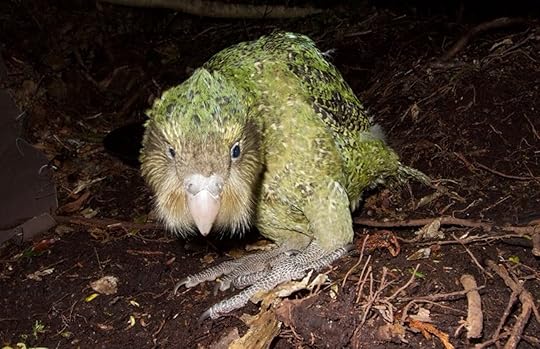
Photo: Department of Conservation/Facebook
The kakapo is a large, flightless, nocturnal, ground-dwelling parrot native to New Zealand. Its story is reminiscent of the plight of the great auk, the now-extinct, penguin-like, large flightless bird of the North Atlantic. Unable to fly away from attackers, both species were found to be easy prey and were killed en masse by the first humans to encounter them. In the case of the kakapo, it was the Polynesian settlers that arrived in New Zealand about 700 years ago.
European settlement of New Zealand accelerated the demise of the kakapo through habitat loss and the introduction of predators like cats, stoats, and rats, and by the mid-1900s, the kakapo had all but disappeared off the face of the Earth.
It took the New Zealand Wildlife Service (now the Department of Conservation) three decades and countless expeditions to find the last remaining viable population of kakapo on Stewart Island at the southernmost tip of New Zealand. To save the last of the kakapo from predation by cats and rats, the birds were translocated to the sanctuaries on three offshore islands by 1997: Codfish Island, Maud Island, and Little Barrier Island. Over the next few decades, introduced predators have been eradicated from these islands, making them suitable for the long-term survival of kakapo.
Thanks to the intensive conservation measures and rigorous protection, the kakapo population grew from 62 birds in 2000 to 142 birds today. And while it is still listed as critically endangered on the IUCN Red List of Threatened Species, hope remains for the future of kakapo. This year saw an unusually long breeding season that produced a record number of kakapo hatchlings — over 70 chicks.
7. Mountain gorilla

Photo: LMspencer/Shutterstock
Mountain gorillas are one of the best-known icons of wildlife conservation. A subspecies of the eastern gorilla, the mountain gorillas survive in two distinct populations. One is confined to Uganda’s Bwindi Impenetrable National Park, and the other is found in the Virunga Massif that stretches across the borders of Rwanda, Uganda, and the Democratic Republic of Congo. It was in Virunga Massif that Dian Fossey established the now-famous Karisoke Research Centre in the 1960s. At the time, mountain gorillas were already heading towards extinction after decades of war, habitat destruction, and poaching.
By 1978, the total population of mountain gorillas in Virunga Massif reached an all-time low of about 240 individuals, which lead to Dr Fossey’s grim prediction that the species would go extinct before the end of the century.
What saved mountain gorillas was the extreme level of conservation and protection. Led by the passionate individuals, some of whom lost their lives to protect the gorillas, the conservation efforts were eventually supported by the governments of Rwanda, Uganda, and the Democratic Republic of the Congo. After decades of intensive on-the-ground protection, the numbers of mountain gorillas began to increase. Today, the population estimate is 1,004 wild gorillas, with just over 600 animals living in Virunga Massif and about 400 individuals in Bwindi Impenetrable National Park.
The increase of the population lead to the re-classification of mountain gorillas by the IUCN from critically endangered to endangered, proving the value of intensive conservation measures in saving species from extinction. 

More like this: The best 8 places to see some of the world’s most majestic animals up close
The post 7 animals saved at the 11th hour, and why there is hope for the world’s species appeared first on Matador Network.

Popular Canada Airbnb host suspended

One of Airbnb’s most popular hosts in Canada has had his account shut down after it was reported by CBC’s investigation team that he was misleading guests about the accommodations and creating fake accounts to boost his own ratings.
The host known as “AJ” rented properties in Montreal and had 90 listings on the website. Thanks to the reviews he gathered, he even obtained the status of “Superhost” at the start of the year — a token that is meant to reassure potential renters about the quality of the service provided.
But the listings were often the same properties advertised on different accounts and the positive reviews were fake — something that could have been easily noticed early on since they all came from the same few fake guests and were just copied and pasted from one listing to another.
The real reviews were not as glorious as the made-up ones — vermin-infested, dirty, and poorly maintained accommodations were run-of-the-mill.
According to CBC, AJ was under investigation since March but his account was not suspended until mid-June. Because Airbnb failed to disable his account, which would have canceled existing bookings, hundreds of guests who had already arranged to stay at one of AJ’ s properties just went ahead with their vacations, unknowing of the situation.
Stacy Lapierre, a Nova Scotia business owner who booked AJ’s “Charming old Montreal Loft” for a July holiday, said to CBC, “The floors were disgustingly dirty. There were broken mugs… The beds were chewed by the mice.” She added that Airbnb should have sent an email notifying her of AJ’s suspension, offering to help find another accommodation, or providing a refund.
But only a week after AJ was blocked from taking new reservations, 45 of his 58 listings mysteriously shifted to new hosts called “Barry” and “Arvin,” whose guests experienced the exact same issues.
As of mid-August, Barry, Arvin, and AJ’s accounts have been suspended from Airbnb for violating “authenticity” and “reliability” standards. Airbnb has vowed to continue to take action against those misrepresenting themselves on its platform. 

More like this: Woman finds guns, typewriter made of human teeth, and more behind locked door in Airbnb
The post Airbnb suspended one of Canada’s most popular hosts, but never notified guests appeared first on Matador Network.

Best rooftop bars in Buenos Aires
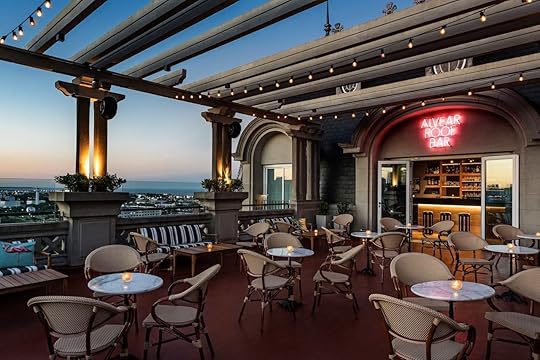
The diverse neighborhoods of Buenos Aires can each necessitate a day to explore, meandering old streets and the architecture driven by the city’s history as a hub for immigrants. The first thing you’ll learn here is that this is a city worth walking. There’s a lot to see, a fact that tends to leave visitors thirsty. The ideal way to solve this is to vertically remove yourself from the bustling neighborhood streets, swapping the street level views for panoramic shots of the city from above. Rooftop bars are located at old iconic buildings throughout the city, ranging in ambience and style from backpacker hostels to high-end hotels and restaurants. Across that spectrum, these are the best rooftops to pop into for a drink in Buenos Aires.
Salon 1023 (Palacio Barolo)

Photo: Salón 1923/Facebook
Located at the top of the Palacio Barolo, one of the most beautiful and iconic buildings of Buenos Aires, this rooftop is Buenos Aires’ place to see and be seen during happy hour. Local business leaders, musicians, and other personalities about town tend to congregate here on top of this historic building. With a great selection of Italian cocktails and live music, Salon 1023 is a great spot to chill out after a long day of walking. The big star of the Barolo is its terrace, where you can watch the marvelous lighthouse with adjacent views of the city from all angles. There are no chairs or tables on the rooftop, but a roofed section nearby will give you the chance to sit down and appreciate the inner architecture of the palace. You may prefer to stand, however, because there’s always a chance you might bump into a local celebrity.
Where: Av. de Mayo 1370, Congreso, Ciudad de Buenos Aires
Alvear Rooftop

Photo: Alvear Roof Bar/Facebook
Many who walk along the sophisticated Alvear Avenue in the posh Recoleta neighborhood tend to stop, stare, and snap a photo of the elegant facade of the Alvear Hotel. With so much outward class, it’s easy to assume access would be restricted. Wrong. You can pop in without invitation or reservation and simply take the elevator to the 11th floor to the warmly lit open terrace. This is for sure one of the chicest, most luxurious rooftop bars in Buenos Aires, and not just because of the Alvear itself but because of the panoramic view of the city you’ll enjoy while having an equally fancy cocktail. This bar offers a relaxed and fun vibe, with light bites available should you need to cleanse the palate between drinks. The rooftop bar is open Tuesday through Saturday year-round from 6:00 PM to midnight.
Where: Av. Alvear 1891, Recoleta, Buenos Aires
Dome Roof Top Bar (Tango de Mayo Hotel)
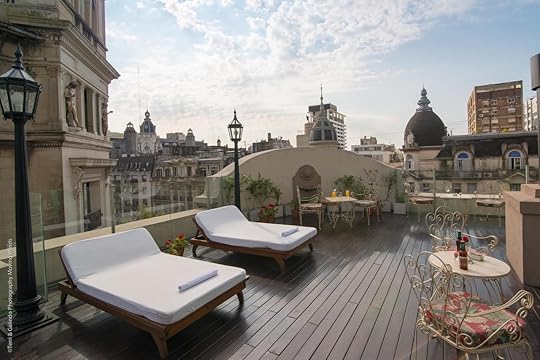
Photo: Tango De Mayo/Facebook
The Dome Roof Top Bar is located at a refurbished 1913 Art Nouveau building that now hosts the Tango de Mayo Hotel, the first tango-themed hotel in this tango-crazed city. The Dome Roof Top Bar maintains exclusive hours, open from 7:00 PM to 1:00 AM, Tuesday to Friday, but if you make it in your reward — beyond the cocktails themselves — is one of the most incredible views of the city’s domed buildings and the nearby Palacio Barolo. All accompanied by a wide variety of classic and signature cocktails. Live music happens over happy hour from 7:00 PM to 9:00 PM.
Where: Av. de Mayo 1396, Congreso, Ciudad de Buenos Aires
Sky Bar (Hotel Pulitzer)
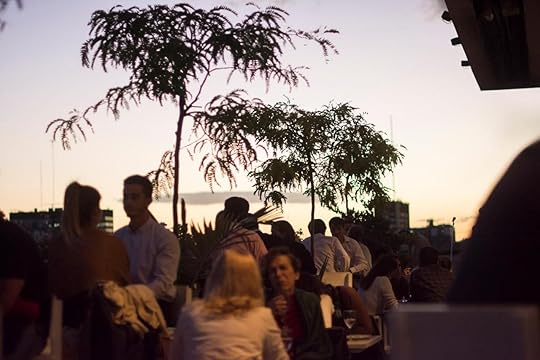
Photo: Hotel Pulitzer Buenos Aires/Facebook
Sky Bar is located on the 13th floor of the fancy Hotel Pulitzer near Plaza San Martín, near the Retiro train station. Its terrace offers a cool and cosmopolitan atmosphere, often with chilled live music to complement the stiff drinks. Sky Bar is a very popular after-work spot for office workers in Buenos Aires, so you should arrive early to secure a good table. Grab one near the edge if possible, as the skyline view at sunset is on par with any in the city. The atmosphere is fun and vibrant, just remember to leave the shorts at home as the dress code is smart casual. The bar is open nightly from 5:00 PM to midnight.
Where: Maipú 907, Retiro, Buenos Aires
Belushi Rooftop Bar

Photo: Belushi Gran Bar/Facebook
Belushi Rooftop Bar and Lounge is a trendy rooftop bar and restaurant in the heart of the cool Palermo neighborhood. Belushi offers a good selection of craft cocktails, beers, and tapas. Its location means you’re likely going to be tightly packed with gallivanting tourists, hip young professionals, and the city’s “in-the-know” crowd, but the Luchese cocktail will have you wondering why Fernet Branca isn’t commonplace in cocktails the world over. If you’re looking for a night out in Palermo, this is the place to begin the evening.
Where: Honduras 5333, Palermo, Buenos Aires
Portal del Sur Hostel

Photo: Tango De Mayo/Facebook
Located near Plaza de Mayo, Portal del Sur Hostel is in the heart of trendy San Telmo. This cool hostel features a rooftop bar that, because of its awesome views and warm atmosphere, draws libation hunters from beyond the hostel’s guest list. Don’t be surprised if you find yourself part of an impromptu jam session here, as an acoustic guitar is never far away. Portal del Sur is a perfect place to meet new people from all over the world while enjoying the heavy-handed drinks and excellent views. Even if a jam session fails to break out, pool tables, ping pong, cards, and various other entertainment options are available. This is the ideal spot to chill out while enjoying the great scenery of old Buenos Aires.
Where: Av. Hipólito Yrigoyen 855, Monserrat, Buenos Aires
Cielo Sky Bar

Photo: Grand Brizo
This rooftop offers one of the most famous views of Buenos Aires — the widest avenue in the world, La Avenida 9 de Julio, and the iconic Obelisco are just below, lined with tourists and locals and making for the perfect cover photo for your trip’s photo album. The drinks are exotic, and so are the people drinking them, in many cases — think vacationing movie stars and the yacht crowd. The Cielo Sky Bar is open from Wednesday to Sunday from 6:30 PM to 11:30 PM, and beyond the photo-op is a place where you should end an early night out — you won’t find a bar classier or more likely to make you feel as though you’re in New York City than this one.
Where: Cerrito 180, Monserrat, Buenos Aires 

More like this: Everything you need to know about asados in Argentina
The post Buenos Aires’ coolest rooftops to go out for a drink appeared first on Matador Network.

The rise of mead

At Brimming Horn Meadery in Delaware, Jon Talkington doesn’t just make honey wine. He’s a storyteller. He regales visitors with Norse mythology and recites Viking poetry. When he opened the meadery in 2017, he wanted the space to evoke ancient Viking drinking halls with chandeliers constructed from antlers hanging from the ceiling and a sword and shield mounted on the wall. Sometimes newcomers walk through Brimming Horn’s door eager to try the mead — other times they want to experience the culture from which the drink originates and don’t have a clue what mead is or where it comes from.
“People think it’s some kind of medieval beer,” Talkington says. “Sometimes they ask for bacon and sausage. I’m like, ‘No there’s a ‘d’ in there.’ Or they think it’s sickly sweet.”
Even if they are novices, Talkington sees more and more people arrive at Brimming Horn every day. He’s been making mead and reading about Norse mythology since the age of 16, but only in the last five years has he seen mead go from niche hobby to mainstream fascination.
The sudden interest in mead could stem from a couple of places. For one thing, the craft beer boom is slowing, and alcohol enthusiasts are eager to find the newest craft adult beverage (“You can only drink so many IPAs,” Talkington quips). There might be another slightly more unexpected reason that mead has experienced a wave in popularity it hasn’t seen since, well, the days of the Vikings: A recent, though enduring, fascination with all things medieval in the realm of pop culture, especially on television.

Photo: RONEDYA/Shutterstock
“A large part of its resurgence has been Game of Thrones,” says Paul Curcillo, co-owner of Earle Estates Meadery in the Finger Lakes in New York.
Curcillo gets a kick out of first-time mead drinkers wandering through his doors, asking the nearest employee “Is this what they drink on Game of Thrones?” He recalls that during the show’s run, and even after it ended (presumably to cope with the ending), newcomers would buy cases of mead to drink while watching the show with friends.
Though mentioned very little (at most once or twice) on Game of Thrones, mead is still strongly associated with knights and warriors drinking merrily after a gritty, raucous battle. In 2019, it seems, people still want to commune with the old gods — from the comfort of their living rooms, of course.
Though mead is slowly gaining popularity, there are plenty of common misconceptions. A major one is that mead is a type of beer. Mead is made from honey (which is perhaps why it has a reputation as saccharine), not grain starches. This technically, according to the US government, puts it in the category of honey wine.
Talkington has noticed that in-the-know medieval-era enthusiasts are turning to mead to add an air of legitimacy to their obsession. Fans of shows like Vikings on the History Channel have stopped by Brimming Horn, as have people who like to recreate medieval society in their spare time. Talkington has met doctors, chiropractors, and dentists — all members of the Society for Creative Anachronism — who learned about mead through the group’s brewers association.
“One of the big ramp-ups for mead was a Bud Lite commercial [that makes fun of a picky mead drinker],” Talkington says. “We have customers come up because they saw the commercial.”
Sergio Moutela, founder of Melovino Meadery in New Jersey and president of the American Mead Makers Association, concedes that he’s met plenty of mead drinkers who broke out bottles for their weekly Game of Thrones watch party, but he doesn’t know anyone who learned about mead from watching the show alone. Instead, he agrees that the mead boom is “riding on the coattails on the craft beer movement.” Most of the visitors to Melovino are craft beer and cider drinkers who are “looking for something different.” In Moutela’s view, they’ve helped push mead into the mainstream.

Photo: Melovino Meadery/Facebook
“There were 70 meaderies in the country when we opened [in 2014]. A new meadery opens up every three days. There are probably 600 now,” Moutela says. “Four or five years ago, all of a sudden everyone that made mead at home was looking into opening a meadery.”
Mead has all the attributes of a trendy beverage in 2019. The majority of mead produced in the United States is hand-crafted, made by family-owned small businesses. Even former Disney Channel star Dylan Sprouse is getting into the mead game, opening up the All-Wise Meadery in Brooklyn last year — which is sure to help further mead’s popularity with an even younger crowd.
Mead was bound to experience a surge of popularity sometime. Thanks to a confluence of serendipitous events, our current cultural moment happens to be perfect. Craft beer seems to have peaked around the same time that medieval culture became a fixture on our televisions.
“Nobody ever really raised their hand in the first three years after I opened Melovino, when I asked, ‘Is anyone familiar with mead?’” says Moutela. “When I ask now, everyone raises their hand.” 

More like this: The best one-day ‘Game of Thrones’ road trip through Northern Ireland
The post ‘Game of Thrones’ may be over, but the mead boom is just beginning appeared first on Matador Network.

Egypt vertical forest
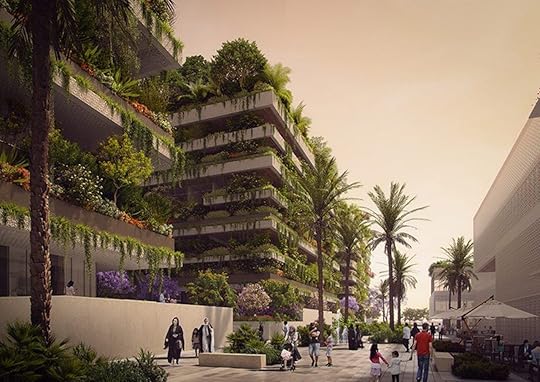
Starting next year, construction is set to begin on Africa’s first vertical forest. The architectural feat has been designed by Italian architect Stefano Boeri and will be built 30 miles east of Cairo, Egypt, in the future new administrative capital of the country. The project is scheduled to be completed in 2022.
The vertical forest will consist of three cube-like apartment blocks that will measure 98 feet by 98 feet and be seven stories tall. The three buildings will be covered with 350 trees and 14,000 evergreen shrubs of over 100 different species.

Photo: Stefano Boeri Architetti
But it’s not all aesthetics — Dezeen explained that the plants will provide natural shading, improve the air quality, absorb seven tons of carbon dioxide, and produce eight tons of oxygen per year.

Photo: Stefano Boeri Architetti
To fight climate change, we are in desperate need of trees, and meeting this demand by incorporating trees that will absorb and store carbon dioxide emissions within the urban landscape is plain genius.
In announcing the vertical forest project, Stefano Boeri expressed his hope that, “Cairo can become the first North African metropolis to take on the great challenge of climate change and ecological conversion.” The firm is also involved in vertical forest initiatives in the Netherlands, Italy, and Albania, which speaks to the growing popularity of green architecture. 

More like this: The 7 most amazing green walls around the world
The post Africa’s first vertical forest is coming to Egypt appeared first on Matador Network.

Fun passport photo shoots

A new experiment from photographer Max Siedentopf is bringing something previously unheard of to the mundane process of getting your passport photos taken — uniqueness. The project, aptly named “Passport Photos,” is juicing up passport photography by allowing off-camera creative situations with objects, animals, and even other people while still coming out with a usable passport photo. As long as there’s a white background, the photos are full color, and your face is unsmiling and facing the camera straight on, just about anything goes.

Photo: Max Siedentopf (Official website/Instagram)

Photo: Max Siedentopf (Official website/Instagram)
Past participants have surrounded themselves with fire, done the splits, or duct-taped themselves to a wall, all for the sake of spicing up the routine. The service is designed to be both fun and productive — you get your necessary passport photo and get to have a bit of creative fun in the process. The choice is up to whatever your imagination can dream up that Siedentopf can make a reality. “The series tries to challenge these official rules by testing all the things you could be doing while you are taking your official document photo,” Siedentopf stated on his website.

Photo: Max Siedentopf (Official website/Instagram)

Photo: Max Siedentopf (Official website/Instagram)
The end result is a passport photo that meets the same requirements as all other approved passport photos. Only you, the photographer, and anyone else involved in your wacky photo shoot will have any knowledge of the nonsense taking place off-camera. You just might have a tough time keeping a straight face the next time you pass through customs. 

More like this: How to get a US passport for your pet
The post This photographer will add a touch of weird to your boring passport photos appeared first on Matador Network.

Matador Network's Blog
- Matador Network's profile
- 6 followers



